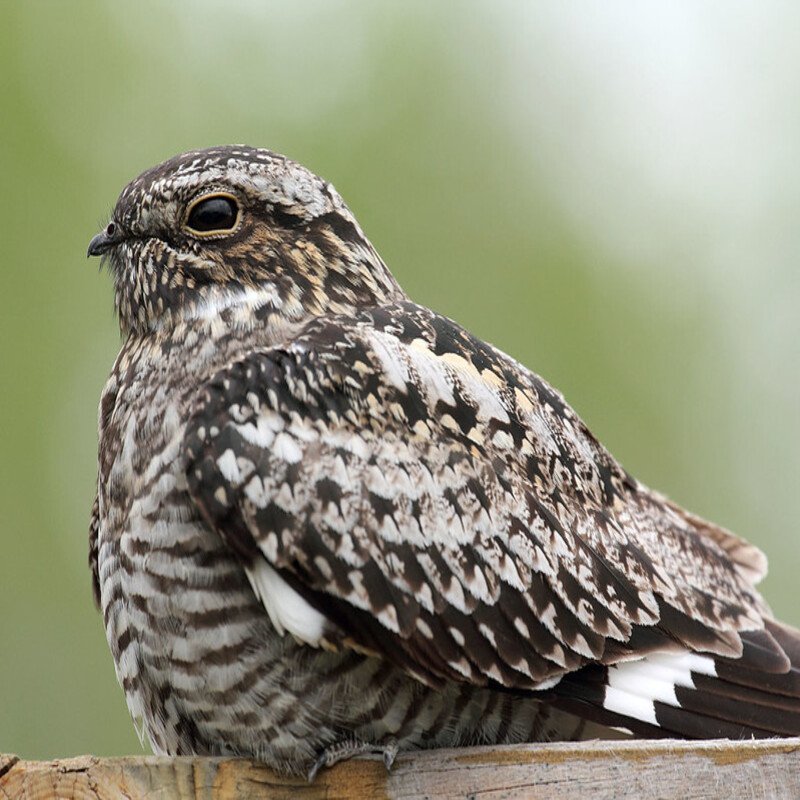Known as Lesser nighthawks, Chordeiles minor is smaller, crepuscular birds of the Americas. Coloration and patterning make this bird difficult to recognize throughout the day. This bird’s flight is bouncy and erratic. A little beak hides the big mouth of this flying insectivore. Some call them owls. It is horizontal.
Quick Overview: Chordeiles Minor – Common Nighthawk
Body size: Around 8-10 in (20-25 cm) and weight of 62 g (2.2 oz)
Main colors: Black, Brown, White
Range: Throughout the United States
Migratory Bird: Yes
Best time of the year to see in the U.S.: June, July, August, September
Conservation Status: Least Concern
Common nighthawk Description
They are moderately large. 22-24 cm, 65-98 g. Unlike other Caprimulgids, they have enormous jaws and eyes. Their wings are sharp, tall, and white on the primaries. No tail band on females, buffier neck. A noticeable barring is seen on both sexes’ breasts and bellies, while the males are whiter. The plumage is light and black. Greater Nighthawks have white under tail coverts, whereas Lesser Nighthawks have buffy undertail coverts, and the primaries’ white wing patch is closer to the wingtip.

Size
These birds have a length of 8-10 in (20-25 cm) and a weight of 62 g (2.2 oz). Their wings could range from 21-24 in (53-61 cm).
Feeding
Nighthawks are nocturnal. Awake and dusk active, seldom feeding at night. They have been observed feeding during the day in poor light. The “hawk” insects with their huge jaws. Their big eyes help them detect prey in the dark. The tapetum (a mirror-like structure at the rear of each eye that reflects light to the retina) helps common nighthawks see in the dark. They fly like bats, capturing up to 50 different insect prey types. The food consists of queen ants, beetles, and true bugs. It also contains flies, wasps, crickets and grasshoppers, among others.
Habitat
Common nighthawks like open places with grasses, bushes, logs, or rocks for cover. They don’t nest. Instead, eggs are placed on sand, gravel, leaves, and exposed rock. Common nighthawks nest on flat gravel rooftops in urban settings.
Behavior
Common nighthawks arrive late in the spring and leave early in the fall. This is because flying insect activity requires warm temperatures in the early evening and morning. Also, unlike certain caprimulgids, common nighthawks do not fall into torpor to preserve energy on chilly nights, making them more vulnerable to cold.
Chordeiles minor Scientific Classification
- Kingdom: Animalia
- Phylum: Chordata
- Subphylum: Chelicerata
- Class: Aves
- Order: Caprimulgiformes
- Family: Caprimulgidae
- Genus: Chordeiles
- Species: Chordeiles minor
Best time of the year to see
The best time to see these birds in the United States is during the summer season (June – September).
Distribution of the Common nighthawk in the USA
Breeds across the contiguous United States, with the exception of the extreme southwest and a large portion of Canada. South America is where the winters are spent.
The Common nighthawk can be found in the following states in the United States – Alabama, Alaska, Arizona, Arkansas, California, Colorado, Connecticut, Delaware, Florida, Georgia, Hawaii, Idaho, Illinois, Indiana, Iowa, Kansas, Kentucky, Louisiana, Maine, Maryland, Massachusetts, Michigan, Minnesota, Mississippi, Missouri, Montana, Nebraska, Nevada, New Hampshire, New Jersey, New Mexico, New York, North Carolina, North Dakota, Ohio, Oklahoma, Oregon, Pennsylvania, Rhode Island, South Carolina, South Dakota, Tennessee, Texas, Utah, Vermont, Virginia, Washington, West Virginia, Wisconsin, and Wyoming.
